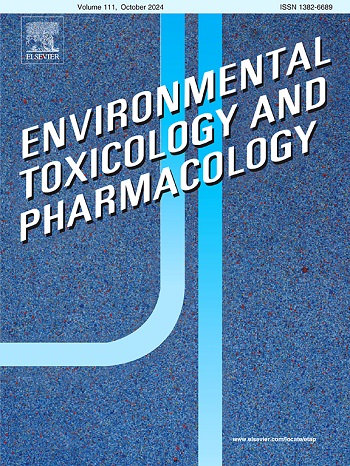早期长期暴露于邻苯二甲酸二(2-乙基己基)酯(DEHP)会损害秀丽隐杆线虫与多巴胺能途径相关的致病性回避行为
IF 4.2
3区 环境科学与生态学
Q2 ENVIRONMENTAL SCIENCES
引用次数: 0
摘要
增塑剂邻苯二甲酸二(2-乙基己基)酯(DEHP)在环境中经常以高浓度被检测到。用于昆虫防治的苏云金芽孢杆菌(Bt)和土壤线虫秀丽隐杆线虫(C. elegans)可能在土壤生态系统中共存。回避行为是生物在波动环境中逃避潜在危险和优化生存所必需的;然而,关于秀丽隐杆线虫对Bt的致病回避行为的研究仍然有限。本研究调查了DEHP暴露是否影响秀丽隐杆线虫的Bt回避及其机制。结果表明,Bt对秀丽隐杆线虫的生长和存活有不利影响。此外,暴露于5 mg/L的DEHP 5天会干扰对Bt的回避行为,但不会影响Bt及其食物源大肠杆菌OP50之间的食物偏好。此外,逃避行为受损与酪氨酸羟化酶同源物cat-2和多巴胺D1受体同源物dop1的下调有关。此外,分子对接分析显示,DEHP与多巴胺D1受体的结合亲和力比多巴胺强。由于DEHP是一种普遍存在的环境污染物,所观察到的秀丽隐杆线虫逃避行为的损害,这是一种重要的生存机制,突出了DEHP暴露对生态系统的潜在环境风险。本文章由计算机程序翻译,如有差异,请以英文原文为准。
Early-life long-term exposure to di(2-ethylhexyl) phthalate (DEHP) impairs pathogenic avoidance behavior associated with dopaminergic pathway in Caenorhabditis elegans
The plasticizer di(2-ethylhexyl) phthalate (DEHP) is frequently detected at high environmental concentrations in the environment. Bacillus thuringiensis (Bt), used for insect control, and the soil nematode Caenorhabditis elegans (C. elegans) likely coexist in soil ecosystems. Avoidance behavior is essential for organisms to evade potential hazards and optimize survival in fluctuating environments; however, research regarding the pathogenic avoidance behavior of C. elegans against Bt is still limited. This study investigated whether DEHP exposure impairs Bt avoidance in C. elegans and the mechanisms involved. Results show that Bt adversely affects the growth and survival of C. elegans. In addition, exposure to 5 mg/L of DEHP for 5 days interferes with the avoidance behavior towards Bt, yet it does not impact the food preference between Bt and its food source Escherichia coli OP50. Furthermore, the impaired avoidance behavior correlates with the downregulation of tyrosine hydroxylase homolog cat-2 and dopamine D1 receptor homolog dop-1. Moreover, molecular docking analysis reveals that DEHP exhibits a stronger binding affinity with the dopamine D1 receptor than dopamine. As DEHP is a ubiquitous environmental contaminant, the observed impairment in avoidance behavior, a crucial survival mechanism for C. elegans, highlights the potential environmental risks of DEHP exposure to the ecosystems.
求助全文
通过发布文献求助,成功后即可免费获取论文全文。
去求助
来源期刊
CiteScore
7.00
自引率
4.70%
发文量
185
审稿时长
34 days
期刊介绍:
Environmental Toxicology and Pharmacology publishes the results of studies concerning toxic and pharmacological effects of (human and veterinary) drugs and of environmental contaminants in animals and man.
Areas of special interest are: molecular mechanisms of toxicity, biotransformation and toxicokinetics (including toxicokinetic modelling), molecular, biochemical and physiological mechanisms explaining differences in sensitivity between species and individuals, the characterisation of pathophysiological models and mechanisms involved in the development of effects and the identification of biological markers that can be used to study exposure and effects in man and animals.
In addition to full length papers, short communications, full-length reviews and mini-reviews, Environmental Toxicology and Pharmacology will publish in depth assessments of special problem areas. The latter publications may exceed the length of a full length paper three to fourfold. A basic requirement is that the assessments are made under the auspices of international groups of leading experts in the fields concerned. The information examined may either consist of data that were already published, or of new data that were obtained within the framework of collaborative research programmes. Provision is also made for the acceptance of minireviews on (classes of) compounds, toxicities or mechanisms, debating recent advances in rapidly developing fields that fall within the scope of the journal.

 求助内容:
求助内容: 应助结果提醒方式:
应助结果提醒方式:


